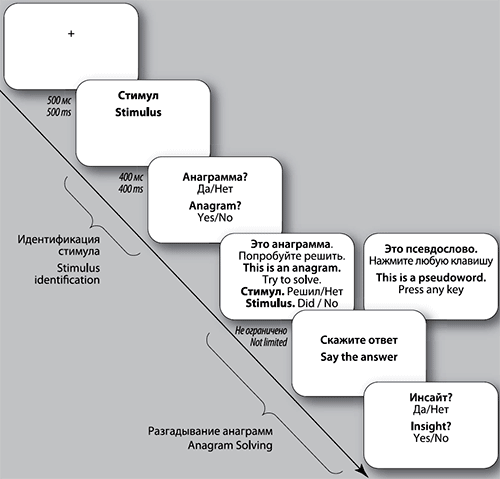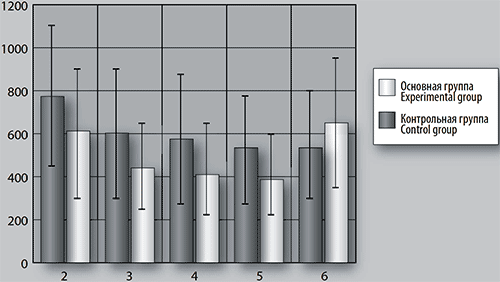Article
Medyntsev A.A., Sabadosh P.A., Kogan A.A., Moskvina V.D., Nemirova S.A., Kayutina D.V. (2020). The role of anticipatory attention in insight and non-insight solutions in the anagram solution task. National Psychological Journal, [Natsional’nyy psikhologicheskiy zhurnal], (13)1, 66–77
Abstract
Background. In modern psychology the study of mechanisms of creative thinking is of great interest. Attention is one of the important factors affecting the operation of intuitive thinking component.
The Objective of the paper is to study the effect of anticipatory attention on the insight and analytical frequency in solving anagrams.
Design. During the experiment, the participants performed two successive tasks. The first task included stimuli identification when the subjects were presented with stimuli — anagrams and pseudowords. The task was to identify the anagram correctly. In the second task (if the stimulus had been the anagram), the participants had to solve the anagram, noting whether the solution was analytical or an insight. The anagram and pseudoword had different letter order. The participants were divided into two groups: the experimental group whose subjects were informed about the difference and were asked to use it for a lexical solution and the control group whose subjects were not informed about the difference.
It was expected that the identification of the anagram in the first task will shape anticipatory attention patterns for the experimental group, which will affect the frequency of insight solutions in the second task. Results. The subjects of the experimental group were found to have a correlation relationship between the speed characteristics of the first and second tasks for analytical solutions. For insight solutions, no such connection was found.
Conclusion. The results demonstrate that insights and analytical solutions are the result of two separate processes of finding solutions that proceed in parallel.
Accepted: 01/16/2020
Pages: 66-77
DOI: 10.11621/npj.2020.0107
PDF: Download
Keywords: insight; anagram; attention; anticipatory attention; creativity; creation;
Available Online 31.03.2020

Fig. 1. Experiment.

Fig 2. Time span of anagram recognition in 2-6 series.
Table 1. Experiment
|
Experimental series |
Incentives |
Differences between incentives |
|
|
Control group (not aware of differences) |
Experimental group (aware of differences) |
||
|
Series 1 Educating |
14 anagrams |
No differences (no pseudo words) |
No differences (no pseudo words) |
|
Series 2–5 Major |
160 anagrams 80 pseudo words |
Differences |
Differences |
|
Series 6 Deviant |
40 anagrams 20 pseudo words |
No differences |
No differences |
Table 2. Time of insight and analytical decisions in two groups, ms
|
|
N |
M |
SD |
MIN |
MAX |
|
|
Experimental group |
Analytical |
35 |
18615 |
9627 |
4105.5 |
49930.5 |
|
Insight |
35 |
10230 |
5988 |
1898 |
29468 |
|
|
Control group |
Analytical |
39 |
16250 |
9574 |
4631.5 |
56631 |
|
Insight |
39 |
7533 |
3925 |
1489 |
15846 |
|
Acknowledgment
This work was supported by the RFBR grant No. 18-013-00765
References:
Bowden E.M., Jung-Beeman M., Fleck J., & Kounios J. (2005). New approaches to demystifying insight. Trends in Cognitive Sciences, 9(7), 322–328. doi: 10.1016/j.tics.2005.05.012
Bowden E., & Jung-Beeman M. (2003). Aha! Insight experience correlates with solution activation in the right hemisphere. Psychonomic Bulletin & Review, 10(3), 730–737. doi: 10.3758/BF03196539.
Brunia C., & Van Boxtel G. (2004). Anticipatory attention to verbal and non-verbal stimuli is reflected in a modality-specific SPN. Experimental brain research, 156(2), 231–239. doi:10.1007/s00221-003-1780-2.
Dale C., Simpson G., Foxe J., Luks T., & Worden M. (2008). ERP correlates of anticipatory attention: Spatial and non-spatial specificity and relation to subsequent selective attention. Experimental brain research, 188(1). 45–62. doi:10.1007/s00221-008-1338-4.
Danek A. H., & Wiley J. (2017). What about false insights? Deconstructing the Aha! Experience along its multiple dimensions for correct and incorrect solutions separately. Frontiers in Psychology. 7, 1–14. doi: 10.3389/fpsyg.2016.02077
Ellis J.J., Glaholt M.G., & Reingold E.M. (2011). Eye movements reveal solution knowledge prior to insight. Consciousness and Cognition. 20(3), 768–776. doi: 10.1016/j.concog.2010.12.007
Friedman R., Fishbach A., Förster J., & Werth L. (2003). Attentional Priming Effects on Creativity. Creativity Research Journal, 15, 277–286. doi:10.1207/ S15326934CRJ152&3_18.
Gazzaley A., & Nobre A. (2011). Top-down modulation: Bridging selective attention and working memory. Trends in cognitive sciences. 16(2), 129–135. doi:10.1016/j.tics.2011.11.014.
Johnston J.C., & McClelland J.L. (1974). Perception of letters in words: Seek not and ye shall find. Science, 184, 1192–1194. doi: 10.1126/ science.184.4142.1192
Jung-Beeman M., Bowden E.M., Haberman J., Frymiare J.L., Arambel-Liu S., Greenblatt R., Reber P.J., & Kounios J. (2004). Neural activity when people solve verbal problems with insight. PLoS Biology, 2(4), 500–510. doi: 10.1371/journal.pbio.0020097
Kounios J., Fleck J., Green D., Payne L., Stevenson J., Bowden E., & Jung-Beeman M. (2008). The origins of insight in resting – state brain activity. Neuropsychologia, 46, 281–291. doi: 10.1016/j.neuropsychologia.2007.07.013
Kounios J., Frymiare J.L., Bowden E.M., Fleck J.I., Subramaniam K., Parrish T.B., & Jung-Beeman M. (2006). The Prepared Mind. Psychological Science, 17(10), 882–890. doi: 10.1111/j.1467-9280.2006.01798.x
Kutas M., & Federmeier K.D. (2000). Electrophysiology reveals semantic memory use in language comprehension. Trends in Cognitive Sciences, 4(12), 463–470. doi: 10.1016/S1364-6613(00)01560-6
Lyashevskaya O.N., & Sharov S.A. (2009). Frequency dictionary of the modern Russian language (based on the materials of the National Corps of the Russian Language). Moscow, Azbukovnik.
Machinskaya R.I., Talalay I.V., & Kurgan A.V. (2015). Functional organization of the cerebral cortex with directed and implicit modal-specific anticipating attention. Alpha-rhythm coherence analysis in the space of sources. [Zhurnal vysshey nervnoy deyatel’nosti imeni I.P. Pavlova], 65(6), 661–675.
Marchetti, F & Mewhort, Douglas. (1986). On the word-superiority effect. Psychological research, 48, 23–35. doi: 10.1007/BF00309276.
Martindale C., & Armstrong J. (1974) The relationship of creativity to cortical activation and its operant control. The Journal of Genetic Psychology. 124, 311–320. doi: 10.1080/00221325.1974.10532293
Martindale C., & Hasenfus N. (1978). EEG differences as a function of creativity, stage of the creative process, and effort to be original. Biological psychology. 6, 157–167. doi: 10.1016/0301-0511(78)90018-2
Medyntsev A.A. (2014). The role of automatic processes in “solutions to insight” in the task of solving anagrams. [Materialy 6oy mezhdunarodnoy konferentsii po kognitivnoy nauke (g. Kaliningrad, 23–27 iyunya)]. Kaliningrad, 421.
Medyntsev A.A. (2017). The Impact of Implicit Prompts on Automatic Information Processing in Anagram Solving. [Experimental’naya Psikhologiya]. 10(1), 23–37. doi: 10.17759/exppsy.2017100103
Mendelson G., & Griswold B. (1964). Differential use of Incidental stimuli in problem solving as a function of creativity. Journal of abnormal and Social Psychology, 68, 431–436. doi: 10.1037/h0040166
Metcalfe J., & Wiebe D. (1987). Intuititon in insight and noninsight problem solving. Memory and cognition, 15(3), 238–245. doi: 10.3758/BF03197722
Novick L.R., & Sherman S.J. (2003). On the nature of insight solutions: Evidence from skill differences in anagram solution. The Quarterly Journal of Experimental Psychology, Section A, 56(2), 351–382. doi: 10.1080/02724980244000288
O’Craven K.M., Rosen B.R., Kwong K.K., Treisman A., & Savoy R.L. (1997). Voluntary attention modulates fMRI activity in human MT-MST. Neurone, 18(4), 591–598. doi: 10.1016/S0896-6273(00)80300-1
Ponomarev Ya. A. (1960). Psychology of creative thinking. Moscow, APN RSFSR.
Ponomarev Y. A. (1976). Psychology of creativity. Moscow, Nauka.
Rawlings D. (1985). Psychoticism, creativity and dichotic shadowing. Personality and Individual Differences, 6(6), 737–742. doi: 10.1016/0191- 8869(85)90084-4
Razumnikova O.M., & Yashanina A.A. (2015). Divergent and convergent thinking as components of creativity: the role of memory and selective processes. In A.L. Zhuravlev, D.V. Ushakov, & M.A. Kholodnaya [Sovremennye issledovaniya intellekta i tvorchestva Ser. «Eksperimental’nye issledovaniya»]. Institut psikhologii RAN. Moscow, 93–106.
Reber A.S. (1967). Implicit learning of artificial grammars. Journal of Verbal Learning and Verbal Behavior. 6, 855–863. doi: 10.1016/S0022- 5371(67)80149-X
Reber P.J., & Squire L.R. (1994). Parallel brain systems for learning with and without awareness. Learning & Memory, 1(4), 217–229. doi: 10.1037/ e537272012-197
Salvi C., Bricolo E., Kounios J., Bowden E., & Beeman M. (2016). Insight solutions are correct more often than analytic solutions. Think Reason. 22(4), 443–460. doi: 10.1080/13546783.2016.1141798
Shaw G.A., & Conway M. (1990). Individual differences in nonconscious processing: The role of creativity. Personality and Individual Differences, 11(4), 407–418. doi: 10.1016/0191-8869(90)90224-F
Spiridonov V.F., & Lifanova S.S. (2013). Insight and mental operators, or is it possible to solve the insight problem step by step. [Psikhologiya. Zhurnal Vysshey shkoly ekonomiki], 10(3), 54–63.
Topolinski S., & Reber R. (2010). Gaining insight into the “Aha” experience. Current Directions in Psychological Science, 19(6), 402–405. doi: 10.1177/0963721410388803
Talalay I., & Machinskaya R. (2014). The comparative study of cued and implicit anticipatory attention during the performance of visual and auditory versions of the temporal order judgment task. The Russian Journal of Cognitive Science, 1(4), 58–66.
Valueva E.A., & Ushakov D.V. (2015). Signal model of insight: from historical premises to empirical predictions. In eds. A.L. Zhuravlev, D.V. Ushakov, M.A. Cold [Sovremennye issledovaniya intellekta i tvorchestva.] Series «Experimental studies». Institut of Psikhologii, RAN. Moscow, 15–47.
Wegbreit E., Suzuki S., Grabowecky M., Kounios J., & Beeman M. (2012). Visual attention modulates insight versus analytic solving of verbal problems. The Journal of Problem Solving, 4(2), 94–115. doi: 10.7771/1932-6246.1127
Weiss S., Meltzoff A., Marshall P. (2018). Neural measures of anticipatory bodily attention in children: Relations with executive function. Developmental Cognitive Neuroscience, 34, 148–158. doi:10.1016/j.dcn.2018.08.002.
For citing this article:
Medyntsev A.A., Sabadosh P.A., Kogan A.A., Moskvina V.D., Nemirova S.A., Kayutina D.V. (2020). The role of anticipatory attention in insight and non-insight solutions in the anagram solution task. National Psychological Journal, [Natsional’nyy psikhologicheskiy zhurnal], (13)1, 66–77


